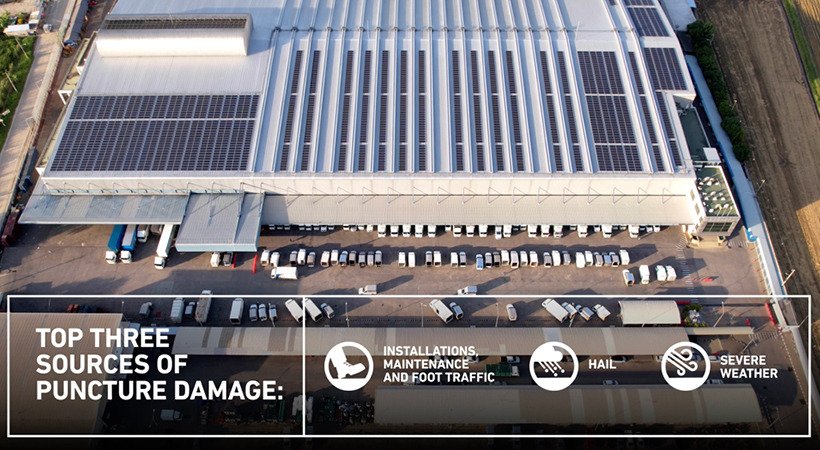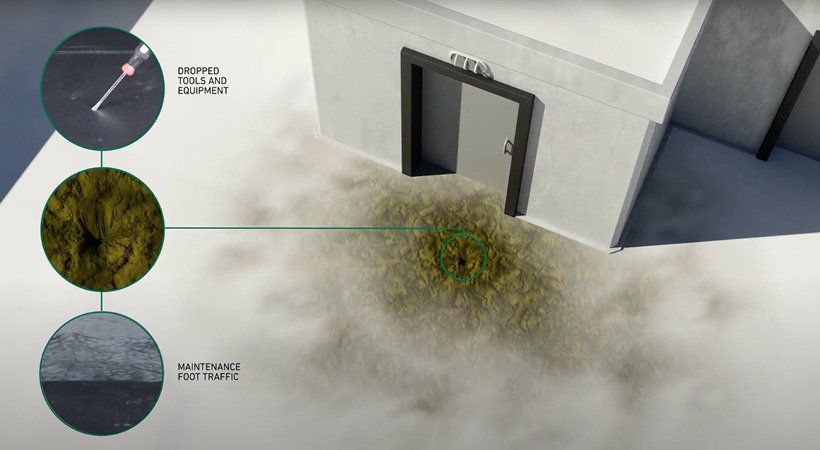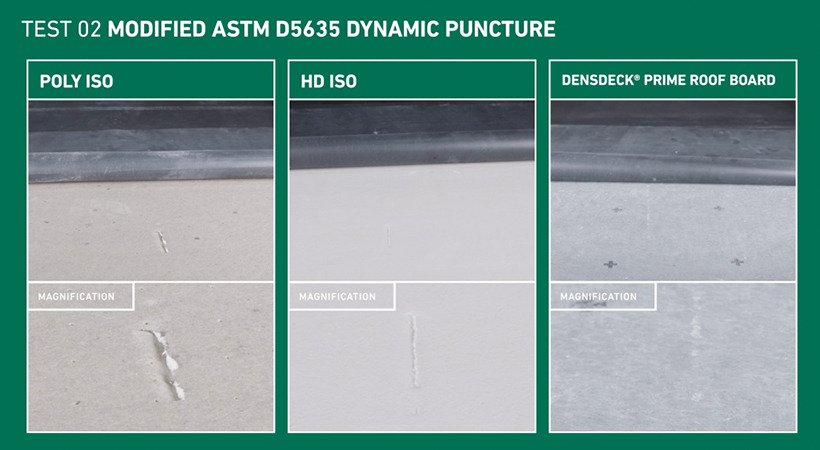How to Defend Your Commercial Roof from Puncture Damage

Sometimes the best way to figure out a solution is to get insight directly from people who deal with the problem. When contractors were surveyed by Ducker Worldwide in 2016 , they ranked puncture as the top threat to a commercial roof’s lifespan. In addition to causing potential damage to entire buildings and the businesses inside, puncture hazards happen in a variety of ways.
Divots, Dings and Holes
First off, punctures can happen during initial construction, even before any additional rooftop enhancements are added. At this point they often result from repeat foot traffic and dropped tools. When you install anything else on a roof, (like solar panels or HVAC systems) the potential for punctures grows. They are likely to occur both during installation and when a system is being maintained.
Punctures can also arise during severe storms when a roof is hit by flying debris, or from the storm itself—when hail is involved. The rising threat of severe weather has made hail a legitimate concern when it comes to the longevity of your commercial roofs.

Extreme Weather Comes Knocking
Billion-dollar weather disasters have become more common in the last 40 years. The frequency of severe storm disasters is increasing faster than any other disaster type, with 70% of their average property losses attributed to hail.
That’s because hail can be a beast. The largest hailstones may exceed 4-inches in diameter and reach speeds over 100 mph. These flying hammers can cause excessive damage to cars, homes and commercial buildings. They’re also dangerous to livestock and people.
The Persistent Threat of Small Punctures
Regardless of how they were made, small punctures often don’t look threatening from afar. But ignoring them would be a big mistake. If left unattended, a small puncture can damage your entire roofing system over time.
For example, when a crew installs solar panels, they may make multiple trips to the roof, carrying tools and other heavy gear. Even a small hole that goes unnoticed can quickly allow water to seep into a roof assembly. If moisture spreads unchecked, mold may grow and weaken the structure without anyone realizing it.

The risk increases as solar panels and green roofs become more popular. The Solar Energies Industry Association predicts the US solar industry to nearly triple in size between 2023 and 2028. When solar panels are mounted on low-slope commercials roofs, they require a rigid substrate to handle the load and help protect the roof system.
Increase Your Roofs’ Durability
Gypsum cover board, like DensDeck® Roof Boards, can help protect against punctures and other kinds of damage. They may relieve static pressure caused by the weight of rooftop enhancements. In addition, they bring increased strength, plus fire and wind uplift resistance.
Need proof? They’ve also been put to the test. Three assemblies, one without a cover board, one using HD ISO, and one with DensDeck® Prime Roof Board—were exposed to controlled hammer drops to simulate impact events like flying debris during severe weather. The membranes on both the assembly without a cover board and the assembly with HD ISO were scuffed up. This kind of wear can cause damage to the substrates underneath. Multiple strikes of this nature could lead to significant punctures over time. This kind of trauma can put the entire roofing assembly at risk.
Meanwhile, the assembly using DensDeck® Prime Roof Board stood strong, protecting all parts of the assembly from impact.

Using gypsum cover board has long-term benefits. It can help extend the life expectancy of a commercial roof by four years. It can also help reduce operation and maintenance costs by an average of $1.40 per square foot over a 20-year lifespan.
While less-expensive solutions may seem attractive, when you stand by gypsum roof board specifications you can improve a building’s resiliency and protect its owner’s investment. And though it’s not always required, specifying cover board in roofing assemblies can help prevent the expense and inconvenience of roof repairs for all stakeholders involved.
When a contracting crew gets a callback for a repair on a recently completed commercial roof job, it can completely disrupt their project timelines and delay the start of new roof jobs. Using a cover board can help contractors stay busy working on new roofs instead of handling costly callbacks to past jobsites. It can also help protect a roofing company’s margins while building a reputation for using only the best materials in the business.
Regardless of your role on the job, it’s worth giving the strategic investment of high-quality gypsum roof boards your consideration. In addition to the benefits mentioned above, DensDeck® Roof Boards have fiberglass mat facers, which are shown to resist delamination, deterioration and warping more effectively than paper-faced materials and other traditional roofing products.
Watch our video on how to mitigate the risk of puncture damage by adding a gypsum cover board like DensDeck® Roof Boards directly under the roof membrane. You’ll see the boards as they’re put to the test, proving they can support and add impact protection to both the membrane and insulation of your roofs.